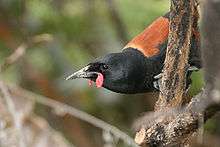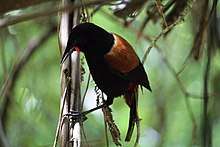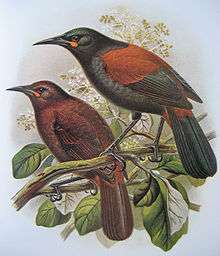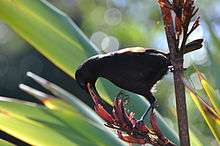Saddleback (bird)
The saddlebacks (Māori: tīeke) are two species of New Zealand bird of the family Callaeidae. Both are glossy black with a chestnut saddle. Its taxonomic family is also known as that of the (New Zealand) "wattlebirds" and includes the two subspecies of the kōkako (the extant North Island kokako monitored on island sanctuaries, and the extinct South Island kokako) as well as the extinct huia. All members of this family have coloured fleshy appendages on either side of the beak known as "wattles". In the case of the saddlebacks, they are a vivid red in colour.
| Saddleback | |
|---|---|
 | |
| North Island saddleback (Philesturnus rufusater) | |
| Scientific classification | |
| Kingdom: | Animalia |
| Phylum: | Chordata |
| Class: | Aves |
| Order: | Passeriformes |
| Family: | Callaeidae |
| Genus: | Philesturnus I. Geoffroy Saint-Hilaire, 1832 |
| Species | |
|
P. rufusater | |


Taxonomy
Its common name is derived from the demarcated brown plumage on its back which resembles a saddle. The Maori name tīeke comes from the particular sound of one of this species' common calls: ti-e-ke-ke-ke-ke.
There are two species:
- North Island saddleback — Philesturnus rufusater
- South Island saddleback — Philesturnus carunculatus
The saddlebacks appear to be a remnant of an early expansion of passerines in New Zealand and are two of five New Zealand wattlebirds of the family Callaeidae, the others being the extinct huia, the endangered North Island kōkako, and the probably extinct South Island kōkako. New Zealand wattlebirds have no close relatives apart from the stitchbird, and their taxonomic relationships to other birds remain to be determined.[1]
Behaviour
Saddlebacks are larger than other arboreal insectivorous birds in New Zealand forests, measuring up to 25 cm (10 in) in length and weighing up to 75 grams (somewhat larger than a common blackbird). They will tear pieces of bark from tree trunks to find insects beneath, which are then dispatched and consumed with their short, robust, and unusually strong beak, but they will also feed on the ground in leaf litter. Their diet is not strictly insectivorous in nature and they have been observed eating fruit and drinking nectar. Poor fliers like their close relative the kōkakos, saddlebacks mostly bound from branch to branch but can fly noisily over short distances. Territorial birds, saddlebacks display antagonistic behaviour in this regard on three levels of intensity, singing out at dawn to mark their territory, making threat displays, which can include head bobbing, tail fanning, and warbling displays (at the same time the wattles become dilated), and finally, when a direct challenge is made to a bird's territory, fights can occur in which combatants attempt to grapple with the wattles of their foe.
The birds are notoriously fearless and noisy, and would frequently enchant European naturalists in the 19th century with their behaviour. Saddlebacks will nest in epiphytes, tree fern crowns, or holes in tree trunks.
They have a tendency to nest near the ground, and their fledglings will also leave the nest to hop around in a typically noisy fashion on the ground while they build up strength in their wings.
Saddlebacks and people
Place in Māori culture
Saddlebacks traditionally held a strong place in Maori superstitious belief; their cries were viewed as good omens when they came from the right, and bad omens when they came from the left. Their cheeky nature is reflected in the Māori legend that tells of how the birds acquired its distinctive chestnut coloured saddle. Fresh from his battle to ensnare the sun, a thirsty Maui (a virtual demi-god in Māori folklore) asked the tīeke to bring him some water. The bird rudely pretended not to hear his request, at which Maui, becoming angry, seized it with his still fiery hand, leaving a brown scorch mark across its back.
Decline, present day conservation and recovery
Their breeding behaviour (nesting near the ground and fledglings hopping noisily around on the ground) make them especially vulnerable to predation from introduced mammals, including mustelids, Norway and ship rats. This resulted in both species swiftly disappearing from the New Zealand mainland. By the beginning of the 20th century, both species were confined to a respective island in the far north: Hen Island off Northland, and in the far south, Big South Cape Island off Stewart Island/Rakiura.
Rats arrived on Big South Cape Island in 1963, accidentally introduced as they escaped from the boats of visiting muttonbirders. Only a swift rescue operation by the New Zealand wildlife service (the present day Department of Conservation) saved both species from extinction by the skin of their teeth, while the rats' predation soon condemned to extinction the local populations of the South Island snipe, bush wren and greater short-tailed bat.
Saddleback have since been relocated to island nature reserves around New Zealand, and also to mainland fenced sanctuaries. Since roughly 2015, sporadic sightings and evidence of breeding has been confirmed in Polhill Reserve, which neighbours the fenced Zealandia wildlife sanctuary. These have been the first sightings on New Zealand's un-fenced mainland since the bird was declared extinct on the mainland in 1910.[2]
The recovery of the saddleback is considered by many to be one of New Zealand's greatest conservation success stories.
Gallery
 Adult in front, young of South Island subspecies at rear (from Walter Buller's Birds of New Zealand)
Adult in front, young of South Island subspecies at rear (from Walter Buller's Birds of New Zealand) Feeding from a flax flower
Feeding from a flax flower- A saddleback on Ulva Island, New Zealand, an island bird sanctuary located off Stewart Island/Rakiura (where a sizable population of South Island saddlebacks is maintained).
References
- Ewen, John G; Flux, Ian; Ericson, Per GP (2006). "Systematic affinities of two enigmatic New Zealand passerines of high conservation priority, the hihi or stitchbird Notiomystis cincta and the kokako Callaeas cinerea (fulltext)" (PDF). Molecular Phylogenetics and Evolution. 40 (1): 281–84. doi:10.1016/j.ympev.2006.01.026. PMID 16527495. Retrieved 16 July 2016.
- Wannan, Olivia (2015-12-28). "Saddleback youngster spotted outside Zealandia". Stuff.co.nz. Retrieved 2018-02-05.
- BirdLife Species Factsheet
- "Wild South: Saving New Zealand's endangered birds"- Rod Morris and Hal smith, Random house NZ limited, 1995.
- "Nature guide to the New Zealand forest"- John Dawson, Rob Lucas, Godwit, 2000
- "Collins handguide to the birds of New Zealand"-Chloe Talbot kelly, Collins, 1982.
- DoC information page: https://www.doc.govt.nz/nature/native-animals/birds/birds-a-z/saddleback-tieke/
External links
| Wikimedia Commons has media related to Philesturnus carunculatus. |
- Information page - Department of Conservation
- Information page - TerraNature
- Information page - Zealandia
